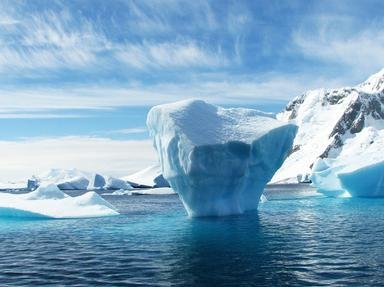Quiz Answer Key and Fun Facts
1. Let's figure out just what is included in the polar regions -- that is, the region north of the Arctic Circle and the region south of the Antarctic Circle. Why is the Arctic Circle drawn where it is on the globe?
2. The line of the Arctic Circle crosses three continents: Asia, Europe, and North America. How many continents are crossed by the Antarctic Circle?
3. If you go to the Arctic and get out your compass, you'll soon find that the geographic North Pole and the North Magnetic Pole are not the same thing. Do both of them stay in a single location, year to year and decade to decade?
4. The Pacific Ring of Fire is justly famous for its many volcanoes and seismic faults, but many people fail to realize that it extends even into a land of snow and ice: Antarctica. In fact, Ross Island is home to the world's southernmost active volcano, Mt. Erebus. How were Mt. Erebus and its neighbor, Mt. Terror, named?
5. Just south of the Arctic Circle is one of the most momentous bodies of water in the history of humankind. This strait now separates Russia and Alaska, but, during the Ice Age, the continents were connected here by a narrow bridge of land. And, more than ten thousand years ago, people ventured across that bridge and thus discovered, explored and settled the Americas. What is the name of the strait?
6. On a map, one of Antarctica's most distinctive features is a long, sinuous peninsula some 800 miles (1300 kilometers) long and bordering the Weddell Sea. Toward which other land mass does the Antarctic Peninsula appear to reach?
7. In days of yore, European explorers sailed the Arctic Ocean, searching for a northerly sea route between Europe and Asia. Now, this once-mythical route is in the news again, as global warming shrinks the Arctic ice pack and offers the prospect of a regular summer shipping lane. By what name is this sea route known?
8. Antarctica is the only continent that human beings didn't manage to settle in antiquity. You might think the Arctic would be just as harsh, but it's home to several hundred thousand people. Which of the following cities is north of the Arctic Circle?
9. Antarctica is cold and dry; much of the continent is actually desert. But, strangely enough, there is surface water if you look in the right place at the right time. Near McMurdo Sound, there's even a river 20 miles (32 kilometers) long. What is its name?
10. The Svalbard Islands, in the far north of the Arctic Ocean, may seem remote, but one day the fate of humanity may be decided on their icy shores. This Norwegian archipelago is home to a high-security vault that houses a massive stockpile of what item, essential for civilization?
Source: Author
CellarDoor
This quiz was reviewed by FunTrivia editor
gtho4 before going online.
Any errors found in FunTrivia content are routinely corrected through our feedback system.


